
Euhelopus is a genus of sauropod dinosaur that lived between 145 and 133 million years ago during the Berriasian and Valanginian stages of the Early Cretaceous in what is now Shandong Province in China. It was a large quadrupedal herbivore. Like sauropods such as brachiosaurs and titanosaurs, Euhelopus had longer forelegs than hind legs. This discovery was paleontologically significant because it represented the first dinosaur scientifically investigated from China: seen in 1913, rediscovered in 1922, and excavated in 1923 and studied by T'an during the same year. Unlike most sauropod specimens, it has a relatively complete skull.

Huabeisaurus was a genus of dinosaur from the Late Cretaceous. It was a sauropod which lived in what is present-day northern China. The type species, Huabeisaurus allocotus, was first described by Pang Qiqing and Cheng Zhengwu in 2000. Huabeisaurus is known from numerous remains found in the 1990s, which include teeth, partial limbs and vertebrae. Due to its relative completeness, Huabeisaurus represents a significant taxon for understanding sauropod evolution in Asia. Huabeisaurus comes from Kangdailiang and Houyu, Zhaojiagou Town, Tianzhen County, Shanxi province, China. The holotype was found in the unnamed upper member of the Huiquanpu Formation, which is Late Cretaceous (?Cenomanian–?Campanian) in age based on ostracods, charophytes, and fission-track dating.
Daanosaurus was a genus of dinosaur. It was a sauropod which lived during the Late Jurassic. It lived in what is now China, and was similar to Bellusaurus.

Liaoningosaurus is an unusual genus of basal ankylosaurid dinosaur from the Liaoning Province, China that lived during the Early Cretaceous in what is now the Yixian and Jiufotang Formation. The type and only species, Liaoningosaurus paradoxus, is known from more than 20 specimens, with some representing juveniles. It was named in 2001 by Xu, Wang and You.
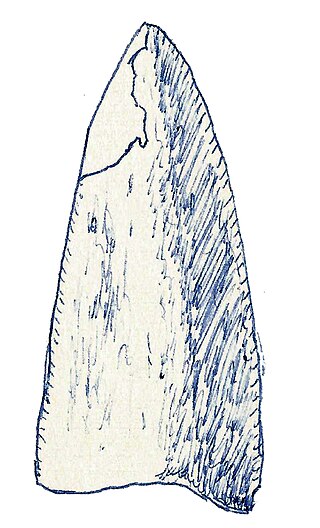
Mongolosaurus is a genus of titanosauriform sauropod dinosaur which lived during the Early Cretaceous of China.

Phuwiangosaurus is a genus of titanosaur dinosaur from the Early Cretaceous (Valanginian-Hauterivian) Sao Khua Formation of Thailand. The type species, P. sirindhornae, was described by Martin, Buffetaut, and Suteethorn in a 1993 press release and was formally named in 1994. The species was named to honor Princess Maha Chakri Sirindhorn of Thailand, who was interested in the geology and palaeontology of Thailand, while the genus was named after the Phu Wiang area, where the fossil was discovered.
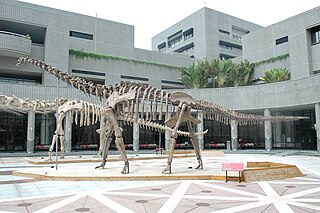
Huanghetitan, is a genus of sauropod dinosaur from the early Cretaceous Period. It was a basal titanosauriform which lived in what is now Gansu, China.
Fusuisaurus is a genus of sauropod dinosaur from the Early Cretaceous of China. Fragmentary postcranial remains of this animal have been discovered in 2001 in the Napai Formation of Guangxi, China and consist of the left ilium, left pubis, anterior caudals, most of the dorsal ribs and distal end of the left femur. This sauropod has been described as a basal titanosauriform.
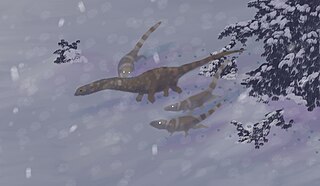
Dongbeititan is a genus of sauropod dinosaur from the Early Cretaceous-age Yixian Formation of Beipiao, Liaoning, China. It is based on holotype DNHM D2867, a partial postcranial skeleton including bones from the limbs, shoulder and pelvic girdles, and vertebrae, which was described in 2007. Its describers suggested it was as a basal titanosauriform, not as derived as Gobititan or Jiutaisaurus, but more derived than Euhelopus, Fusuisaurus, and Huanghetitan. The type species is D. dongi, and it is the first named sauropod from the Yixian Formation, which is part of the well-known Jehol Group. The genus name refers to the region Dongbei and to Greek titan, "giant". The specific name honours the Chinese paleontologist Dong Zhiming. Like other sauropods, Dongbeititan would have been a large quadrupedal herbivore.

Daxiatitan is a genus of sauropod dinosaur known from the Lower Cretaceous of Gansu, China. Its type and only species is Daxiatitan binglingi. It is known from a single partial skeleton consisting of most of the neck and back vertebrae, two tail vertebrae, a shoulder blade, and a thigh bone. At the time of its discovery in 2008, Daxiatitan was regarded as potentially the largest known dinosaur from China.

Ruyangosaurus is a genus of titanosauriform sauropod dinosaur recovered from the Early Cretaceous Haoling Formation of China. The type species is R. giganteus, described in 2009 by Lü Junchang et al.
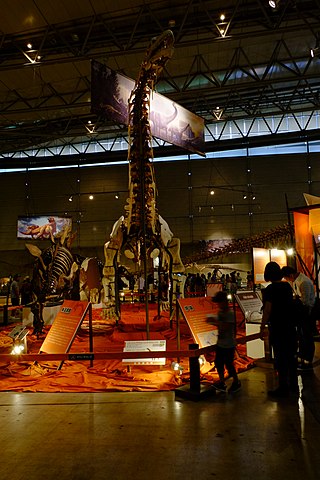
Xianshanosaurus is a genus of sauropod dinosaur from the Early Cretaceous (Aptian-Albian) of the Ruyang Basin in Henan Province, China. Its type and only species is Xianshanosaurus shijiagouensis. It was described in 2009 by a team of paleontologists led by Lü Junchang. Xianshanosaurus may be a titanosaur, and Daxiatitan may be its closest relative, but its evolutionary relationships remain controversial.
Liubangosaurus is a genus of sauropod dinosaur that lived during the Early Cretaceous in what is now China. The type and only species is Liubangosaurus hei, first described by Mo Jinyou, Xu Xing and Eric Buffetaut in 2010. Liubangosaurus is known from the holotype NHMG8152, five complete and articulated middle-caudal dorsal vertebrae that were collected from the Xinlong Formation in Fusui County, Guangxi Province. Mo et al. (2010) found that Liubangosaurus belonged to the clade Eusauropoda.
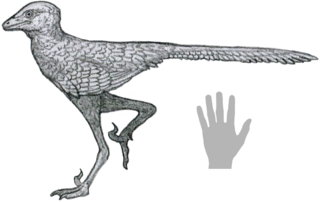
Liaoningvenator is a genus of troodontid theropod dinosaur from the Early Cretaceous of China. It contains a single species, L. curriei, named after paleontologist Phillip J. Currie in 2017 by Shen Cai-Zhi and colleagues from an articulated, nearly complete skeleton, one of the most complete troodontid specimens known. Shen and colleagues found indicative traits that placed Liaoningvenator within the Troodontidae. These traits included its numerous, small, and closely packed teeth, as well as the vertebrae towards the end of its tail having shallow grooves in place of neural spines on their top surfaces.

Sibirotitan is a genus of somphospondyl sauropod from the Ilek Formation of Russia. The type and only species is S. astrosacralis.
Liaoningotitan is a genus of titanosauriform sauropod from the Early Cretaceous (Barremian) Yixian Formation in Liaoning, China.

Abdarainurus is a genus of titanosaur dinosaur from the Alagteeg Formation in Mongolia. The type and only species is A. barsboldi. Currently seen as an indeterminate titanosaur, it may represent a previously unknown lineage of Asian macronarians. Abdarainurus is not known from many remains; it is only known from eight front tail vertebrae and a middle tail vertebra and several chevrons.

Diamantinasauria is an extinct clade of somphospondylan titanosauriform sauropod dinosaurs with close affinities to the Titanosauria, known from the early Late Cretaceous (Cenomanian-Turonian) of South America and Australia. It was named by Poropat and colleagues in 2021, and contains four genera: Australotitan, Savannasaurus and Diamantinasaurus from the Winton Formation of Queensland, as well as Sarmientosaurus from the Bajo Barreal Formation of Patagonia. The existence of the clade indicates connectivity between Australia and South America via Antarctica during the Cretaceous period.

Jiangxititan is an extinct genus of somphospondylan titanosauriform dinosaur from the Late Cretaceous Nanxiong Formation of China. The genus contains a single species, J. ganzhouensis, known from several articulated vertebrae with ribs. Originally described as a titanosaur, Jiangxititan was later suggested to be a non-titanosaurian somphospondylan.

Gandititan is an extinct genus of titanosaurian sauropod dinosaur from the Late Cretaceous Zhoutian Formation of China. The genus contains a single species, G. cavocaudatus, known from a partial skeleton.



























